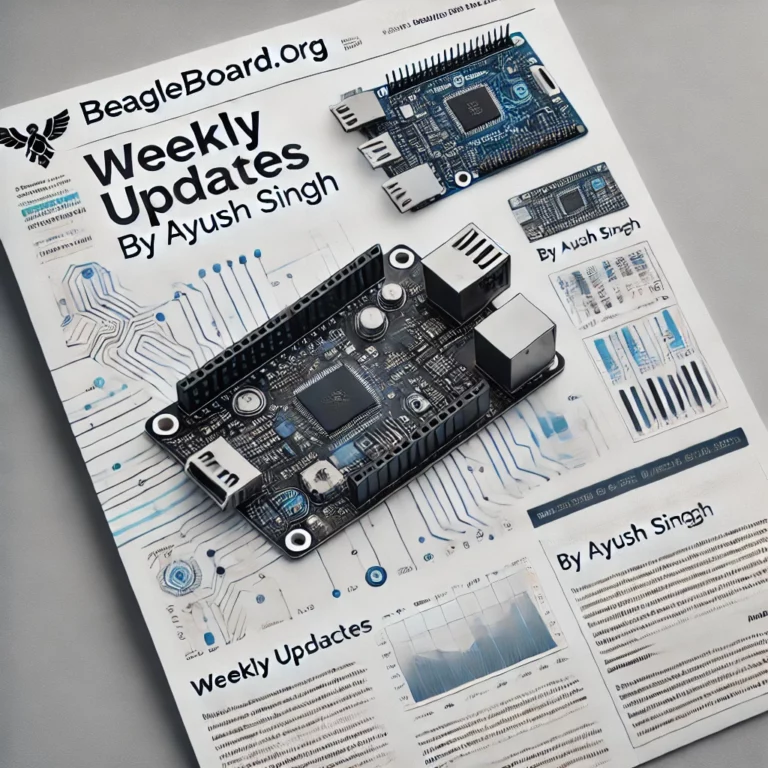Hello everyone. A typical week for development. Let’s go over everything.
Zephyr Ti Hal Updates
A few weeks ago, I created a PR to update the Simplelink SDK version in hal_ti from 4.40.04.04 to 7.41.00.17. Now that it has been merged, hopefully, I can start working on adding Bluetooth support using the BLE5 Stack in the SDK.
BeagleBoard Rust Imager
More work went into the BeagleBoard Rust imager this week. I hope to get the v1.0.0 release out by the end of this month and replace the old bb-imager.
Introducing bb-imager-service
As mentioned last week, I was searching for how to allow PocketBeagle2 MSPM0 firmware update from the GUI. To reiterate the problem, sysfs entries for Firmware Upload API is owned by root user and thus cannot be opened from the GUI without some kind of privilege escalation mechanism. As a reference, in case of SD card flashing, I am using UDisk2 D-Bus APIs to open the SD card, which internally uses polkit for privileged management.
After some googling, I came across the following stack overflow answer:
- You could, of course, write your own D-Bus service which does that and install the D-Bus .service config to have it run as a system service with root privileges. (Try to keep the operations as limited and fine-grained as is reasonable; e.g. “enable global mode foo” – not “write arbitrary data to arbitrary file”.)
- Failing that, one common method is to spawn
pkexecto perform operations, which is… really just su with a nicer password prompt. Note that some distributions have recently removedpkexec. - If your app is allowed to use either GNOME’s GLib or KDE’s KIO libraries, then both of those already have PolicyKit integration built-in for privileged file updates – the app could open admin:///etc/foo and GLib or KIO would elevate as needed.
Since I could not find much regarding the 3rd approach, and the 2nd approach seemed to be on the way out, I ended up going with a custom D-Bus service. I will probably need similar functionality for BeaglePlay cc1352p7, BeagleY-AI, etc., so it is not a bad idea to have a custom d-bus service.
Using zbus was pretty nice, and I have a better understanding of Linux systems, so it ended up being quite a learning experience. I am building a Debian package for the service for now since it is only supposed to be used in PocketBeagle2 right now. It also contains systemd service which activates on D-Bus connection.
The following articles were a lot of help in figuring everything out:
Overhaul config format
The config format I initially started with differed from RPI-imagers since I thought it would be more efficient. However, after adding a lot of boards and flasher types, I realized that every flashing target is not really a board. For example, having different board entries for PocketBeagle2 and PocketBeagle2 MSPM0 seemed weird.
While browsing rpi-imager last week, I found out that it seems to support bootloader updates in different rpi versions. The GUI presentation seemed nice, so after some deliberation, I adopted a format compatible with the RPI-imager’s format. Since the os_list is a self-referential structure in the RPI-imager’s config, it is possible to have a lot of sub-menus in the image selection menu, which is quite nice.
To elaborate, now there are only base boards (e.g., PocketBeagle2) in the Board Selection menu, and the Image Selection menu will have a sub-menu for MSPM0 Firmware support.
Check out the PR for implementation details.
Live destinations refresh
Similar to RPI-imager, destination refresh is now automatic using subscriptions. Check out the PR for implementation details.
Better defaults in Extra Configuration
The application now queries the user’s current system for the default suggestions regarding username, keyboard layout, timezone, etc. Check out the PR for details.
Include udev rules
I have added udev rules to the Linux package of GUI to allow flashing BeagleConnect Freedom without needing superuser privileges. They also make development easier and allow using commands like tio without root.
Ending Thoughts
This was it for this week. Hopefully, this helps bring transparency regarding where the development efforts are concentrated, and how the community can help. Look forward to next update.

